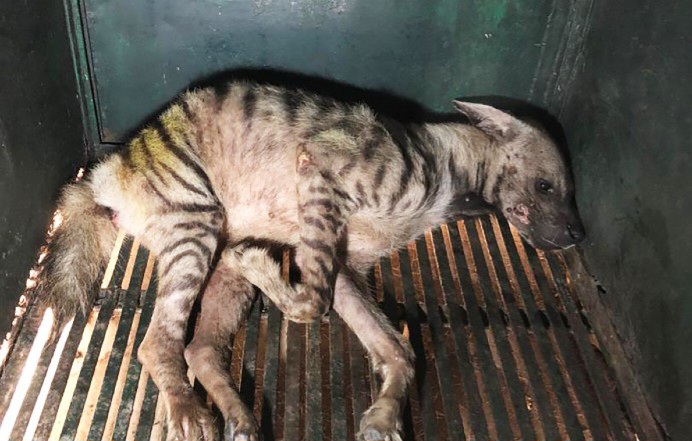
Written and image provided by Bhavani Sundaram
The scenario of animals dying due to rash driving
and careless drivers is increasing day by day be it dogs, elephants, leopards,
lions etc... Each and every animal have a right to way maybe more than humans
as they cannot understand the fact that a speeding car coming their way is
going to injure and kill them. I as an animal lover and worker have seen many
instances of dogs lying crushed and dead in the middle of the roads due to rash
driving and have stopped many a times to move the body to a corner of the road
so that it doesnt keep getting crushed time and time again.
The sad fact is that the
drivers dont seem to care or bother that they are seeing an animal trying to
cross the road, they feel that it is their birthright to drive rashly and bump
into the animal and that it was the animals fault not theirs.
Being a witness to the
cases of hit and run cases in the shelters its heartbreaking seeing animals
being brought in with bones broken, spines broken, and sometimes in their last
moments…it’s a heart wrenching scene for any animal lover and a helpless
feeling …
How can we avoid hitting an animal?
First and
foremost, slow down! Keeping your speed in check gives you a better chance of stopping
in time if an animal darts into the road.
- Follow speed limits. Many animals are hit simply because
people drive too fast to avoid them. Taking it slow makes the roads
safer for other drivers and pedestrians, too.
- Watch for wildlife in and near the road at dawn, dusk and in the
first few hours after darkness. Keep in mind that where there is one
animal, there are probably others—young animals following their mother or
male animals pursuing a female.
- Be especially cautious on two-lane roads bordered by woods or
fields, or where streams cross under roads. Most animal/vehicle collisions occur
on these roads. Slow down to 45 mph or less.
- Scan the road as you drive, watching the edges for wildlife about to
cross. This will also make you more aware of other hazards such as
bicyclists, children at play and slow-moving vehicles.
- Don’t throw trash out car windows. Discarded food pollutes the
environment and creates a hazard by attracting wildlife to the
roads.
- Use your high beams whenever possible.
- Lower your dashboard
lights slightly. You'll
be more likely to see your headlights reflected in the eyes of animals in
time to brake.
How can
we make roads safer?
- Enforce speed limits in areas with deer. The lower the
speed, the fewer collisions with deer.
- Erect fences. One of the most successful
techniques for alleviating deer/vehicle collisions is to use fencing to
prevent deer from crossing roads.
- Install devices that warn deer of oncoming cars: which reflect headlights to
create an optical illusion of a fence and alert deer to oncoming
vehicles, have been reported to reduce deer/vehicle collisions by 60
to 100%; Deer Deter devices alert deer to
oncoming vehicles by combining a strobe light effect with ultrasonic
high-pitched sounds.
- Construct green bridges or wildlife
crossing underpasses to enable wildlife to cross roads without having to
negotiate traffic.
How can
I help an injured animal?
Sometimes
collisions are unavoidable, no matter how careful we are. Here's what to do if
you hit an animal or come across an injured one.
- Do not put your own safety at risk. Unless you can move the animal from
the road in absolute safety, do not attempt to do so. Use your hazard
lights or emergency road flares to warn oncoming traffic of the injured
animal. Never attempt to handle a large animal like a deer, or one that
could give a serious bite, like a raccoon.
- Call someone with the proper training and equipment. When you need assistance, call the
non-emergency number of the local police department and describe the
animal's location. Emphasize that the injured animal is a traffic hazard
to help ensure that someone will come quickly. Stay in the area until help
arrives.
- Use heavy gloves to protect yourself or avoid direct
handling if you try to rescue a small animal yourself. Remember that the
animal doesn't know you are trying to help and may bite or scratch in
self-defense. An old towel is helpful if you need to move an injured
animal.
- Gently coax or place the animal into a cardboard box and transport him/her to an animal
shelter, wildlife rehabilitator or a
receptive veterinarian. If there is a delay, keep the animal in a dark,
warm, quiet place to minimize fear and stress.
- If you accidentally
kill an animal,
try to move the animal off the road—but only if you can do so in complete
safety. Otherwise, report the location of the animal's body to the local
police department, and it will arrange for removal. This will prevent
scavengers from being attracted onto the road and eliminate a potential
traffic hazard.
I hope the above points will help in reducing the death of innocent animals who want to cross the roads peacefully… It is our duty to reduce and lessen the accidents caused to animals due to rash driving.
I
believe that animals should be respected as citizens of this earth. They should
have a right to their own freedom and their own life.
